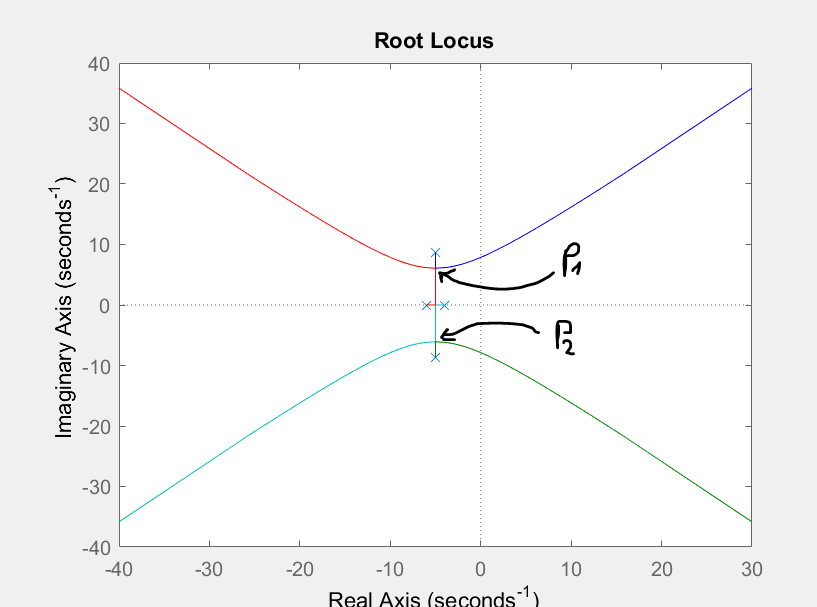I know how to sketch by hand root locus of simpler systems. Consider the root locus which Matlab gives for:
$$G(s) = \frac{1}{(s+4)(s+6)(s^2 + 10s + 100)}$$
 I've marked the points of interest P1 and P2. When the following task was done during class the points were determined by solving for the breakaway point:
$$\sum_{j=1}^{n} \frac{1}{\sigma - P_j} - \sum_{i=1}^{m}\frac{1}{\sigma - N_i} = 0$$
Which when solving yields a real solution and two complex conjugate solutions:
$$\sigma_1 = -5, \sigma_2 \approx -5 + j6, \sigma_3 \approx -5 - j6 $$
Obviously the breakaway point from the real axis is the real solution, however for the points P1 and P2 the two complex conjugate solutions were taken, respectively. I have been unable to find the reasoning behind that in my books and on the internet. My question is how do we determine the points P1 and P2 and why?
I've marked the points of interest P1 and P2. When the following task was done during class the points were determined by solving for the breakaway point:
$$\sum_{j=1}^{n} \frac{1}{\sigma - P_j} - \sum_{i=1}^{m}\frac{1}{\sigma - N_i} = 0$$
Which when solving yields a real solution and two complex conjugate solutions:
$$\sigma_1 = -5, \sigma_2 \approx -5 + j6, \sigma_3 \approx -5 - j6 $$
Obviously the breakaway point from the real axis is the real solution, however for the points P1 and P2 the two complex conjugate solutions were taken, respectively. I have been unable to find the reasoning behind that in my books and on the internet. My question is how do we determine the points P1 and P2 and why?
-
\$\begingroup\$ So your question is why the formula works? If so, I'm pretty sure you will find it in the book or take a look at control systems engineering by nise. Also, you will find another formula for determining the breakaway points. \$\endgroup\$– CroCoCommented Jun 26, 2018 at 3:00
-
\$\begingroup\$ The stability margin is a function of closest distance to axis, that’s why \$\endgroup\$– D.A.S.Commented Jun 26, 2018 at 4:01
2 Answers
The poles for determining the root-locus for an open-loop transfer-function \$H(s)\$ are found using
$$1 + K\cdot H(s) = 0 \Rightarrow K = \frac{-1}{H(s)}$$
The equation holds for any \$s\$ that solves the equation. If \$N > 1\$ poles are hugging in a single point \$\sigma\$, then that means that locally, \$K\$ changes proportionally to \$(s-\sigma)^N\$. This means that the first derivative of \$K\$ will be \$0\$ in this point \$\sigma\$. So we can find these points by solving for
$$\frac{dK}{ds} = 0$$
or similarly
$$\begin{align} \frac{d}{ds}\left( \frac{-1}{H(s)} \right) &= 0 \\ &\Downarrow \\ \frac{1}{H(s)^2}\frac{dH(s)}{ds} &= 0 \\ &\Downarrow \\ \frac{dH(s)}{ds} &= 0 \end{align}$$
A break-away point is defined as the point where the poles leave the real axis. Similarly, a reentry point is where the poles enter the real axis again. However, complex poles can still be kind of "breakpoints" elsewhere on the complex plane, and the above relation will still hold.
Appendix
For rational transfer functions, you can get to the equation in the question by calculating the derivative.
$$H(s) = \frac{\prod_i (s-z_i)^{m_i}}{\prod_k (s-p_k)^{n_k}}$$
With \$k\$ and \$i\$ indexing all poles and zeroes respectively. \$n_k\$ and \$m_i\$ are the multiplicity of their respective pole or zero.
$$\begin{align} \frac{dH(s)}{ds} &= \frac{d}{ds}\left(\prod_i(s-z_i)^{m_i}\right)\prod_k\frac{1}{(s-p_k)^{n_k}} + \frac{d}{ds}\left( \prod_k\frac{1}{(s-p_k)^{n_k}} \right) \prod_i (s-z_i)^{m_i} \\ &= \left( \sum_i \frac{m_i(s-z_i)^{m_i}}{s-z_i}\prod_{j\neq i} (s-z_j)^{m_j} \right) \prod_k \frac{1}{(s-p_k)^{n_k}} \\ &+ \left(\sum_k \frac{-n_k}{(s-p_k)(s-p_k)^{n_k}}\prod_{l\neq k} \frac{1}{(s-p_k)^{n_k}}\right) \prod_i (s-z_i)^{m_i} \\ &= \left( \sum_i \frac{m_i}{s-z_i} - \sum_k \frac{n_i}{s-p_k} \right) \frac{\prod_i (s-z_i)^{m_i}}{\prod_k (s-z_k)^{n_k}} \end{align}$$
So you finally get
$$\sum_k \frac{n_k}{s - p_k} - \sum_i \frac{m_i}{s - z_i} = 0$$
First, maybe you should not use \$P\$ as a notation for the breakaway points, since your formula use it for the transfer function poles. The poles are the value for witch the denominator is 0. Let's call your breakaway points, the "points of interest", \$B_1\$ and \$B_2\$ (and \$B_3\$ for the real one).
\$G(s)\$ has 4 poles:
- \$P_1=-4\$ for \$(s+4)\$
- \$P_2=-6\$ for \$(s+6)\$
- \$P_3=-5+j\sqrt{75}\$, \$P_4=-5+j\sqrt{75}\$, the roots of \$(s^2+10s+100)\$.
\$G(s)\$ has no zeroes, there is no \$N\$.
To get the breakaway points, you need to solve: $$ \sum_{i=1}^4 \frac{1}{\sigma-P_i}=0 $$
That is also: $$ \frac{1}{\sigma+4}+\frac{1}{\sigma+6}+\frac{1}{\sigma+5+j\sqrt{75}}+\frac{1}{\sigma+5-j\sqrt{75}}=0 $$ $$ \frac{2\sigma+10}{(\sigma+4)(\sigma+6)}+\frac{2\sigma+10}{\sigma^2+10\sigma+100}=0 $$ $$ (\sigma+5)\left[\frac{1}{(\sigma+4)(\sigma+6)}+\frac{1}{\sigma^2+10\sigma+100}\right]=0 $$ $$ (\sigma+5)\left[\frac{\sigma^2+10\sigma+62}{(\sigma+4)(\sigma+6)(\sigma^2+10\sigma+100)}\right]=0 $$ The solutions to that equation are \$\sigma_1=-5\$ from \$(\sigma+5)\$, and \$\sigma_2=-5+j\sqrt{37}\$, \$\sigma_3=-5-j\sqrt{37}\$ from \$(\sigma^2+10\sigma+62)\$. Note that \$\sqrt{37}\approx6.0828\approx6\$.
Here you go, the coordinates of \$B_1\$ are given by \$\sigma_2\$, the ones of \$B_2\$ are given by \$\sigma_3\$.
